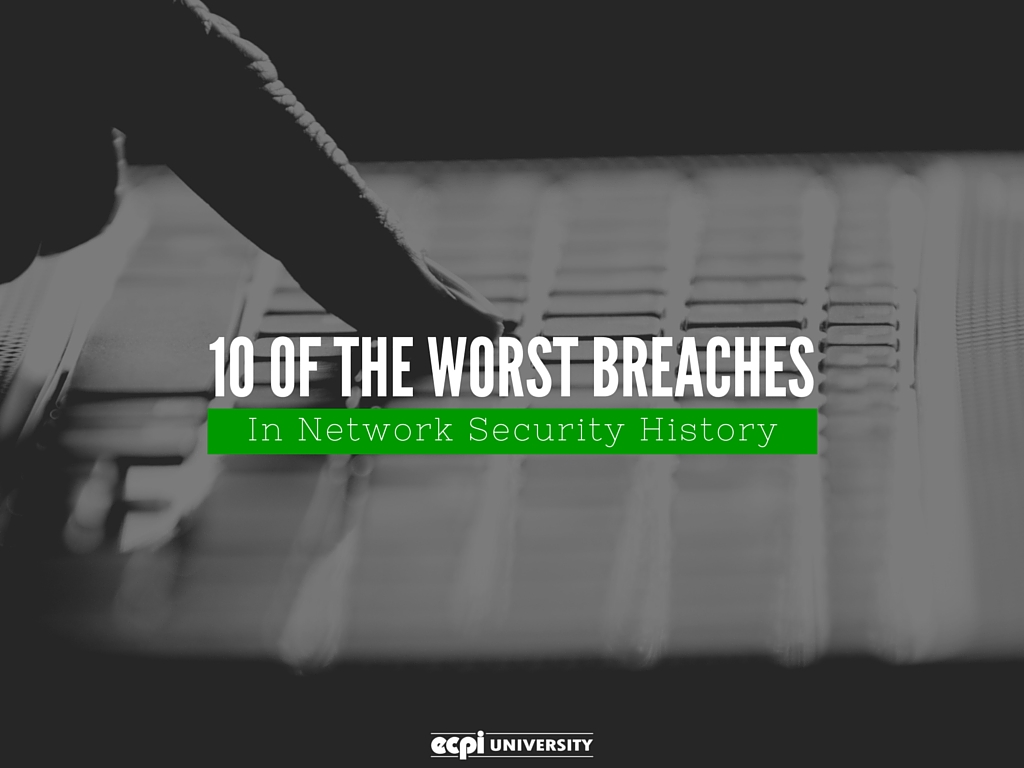
10 of the Worst Breaches in Network Security History
Identifying the ten worst things that have happened in network security history is not as simple as it may seem. If . . . when . . . it happens to you, it hits the top of the list every time.
If you have used the internet, you have undoubtedly experienced a network security hack or privacy invasion. Email, web searches, and social media all open vast opportunities for the hackers. So, here are our candidates for the worst network security events.
10. The First Spammer
Let's start at the beginning. In 1978, Digital Equipment Corp. marketing manager Gary Thuerk sent the first mass email to 393 computers and generated enormous negativity along with a few sales. He is widely credited, or discredited, with being the first spammer. See the original email - innocuous by today’s standards, but it opened the floodgates.
9. A Dreaded Response
In 2006, Blue Security marketed a service that forced spammers to remove recipients from their databases. The New York Times reported that spammers fought back with a Distributed Denial of Service (DDoS) attack. Ten million blogs became unusable for several hours. Two weeks later Blue Security closed up shop.
8. The Hack’s Hack
In another New York Times report, Rupert Murdoch’s News Corp’s weekly, News of the World, got caught hacking the voicemail PINs of prominent celebrities, politicians and crime victims. News Corp executives went to jail, but the implication for everyone was clear: watch what you say . . . or record.
7. Get The Picture?
The Philadelphia Inquirer reported in 2010 that Lower Marion School district spied on students at home through the webcams on laptops issued by their schools. The school district collected 57,000 images of students. Creepy as that sounds, the district justified their spying by saying they were trying to track down lost or stolen laptops . . . yikes.
6. Facesnoop
In 2010, the Wall Street Journal reported on numerous privacy issues at Facebook when it allowed certain apps to receive and share user IDs. Some IDs went to Facebook advertisers who had databases that then tracked the users online.
5. This Worm Covered A Lot of Ground
The Morris Worm, named for its creator, Cornell student, Robert Morris, is significant because of the panic—and awareness—it created as one of the first computer worms distributed over the internet. Morris claimed he wanted to gauge the size of the internet. He did. It’s big. The Government Accountability Office estimated the damage at between $100,000 and $10,000,000, admittedly not a very precise estimate, but you get it.
4. Patients . . . Out of Patience
When California insurer, Healthnet let the public know that the private information of two million customers had been hacked in 2011, their credibility sank and patients' tempers soared through the ceiling. With names, birth dates, addresses, next of kin, social security numbers, and personal medical histories vulnerable, the breach impacts everyone who seeks medical care, which arguably, is everyone . . . eventually.
3. The Zombie King
The FBI calls it the “Case of the Zombie King.” After hacking into Department of Defense systems and infecting 400,000 computers, James Ancheta was caught in a sting operation. His scam was to sell access to other spammers and malicious attackers, allegedly receiving over $100,000 in payments . . . and five years in the slammer.
2. STR8 Brutal Trolling
Seattle’s Jason Fortuny has the dubious distinction of being number two on the list. Identified by the New York Times in 2008 as one of the "Trolls Among Us”, Fortuny posed on Craigslist as a woman seeking “str8 brutal dom muscular male.” He received 178 responses in twenty-four hours . . . along with an embarrassing amount of personal information. Go figure.
1. Kaminsky, You’re the Absolute Worst
And the number one worst thing that has happened on the internet is . . . “The Kaminsky Bug”. Why? The bug, developed in 2008 by Dan Kaminsky, exploits Domain Name System (DNS) servers. Ever been on the internet? Then you have been on one of the DNS servers. Kaminsky allows hackers to imitate web pages or email account IDs on the servers--potentially affecting, and closing, the entire internet.
So there you have it—the worst things to happen in network security, and a reminder that the exponential expansion of the internet has created a demand for trained information security experts. That’s where you could come in!
Discipline Prevails along Network Security Graduate's Path to Cisco - http://t.co/U4Y156WNff via @ECPIUniversity
— ReaLifeSituation (@ReaLifSituation) July 14, 2015
Be the Future of Network Security
Entry into one of the most exciting and rewarding industries can be yours today. Contact ECPI University to find out about our accelerated, year-round program where you could earn a Bachelor of Science in Computer and Information Science with a concentration in Network Security in as little as 2.5 years. It could be the Best Decision You Ever Make!
DISCLAIMER – ECPI University makes no claim, warranty or guarantee as to actual employability or earning potential to current, past or future students or graduates of any educational program we offer. The ECPI University website is published for informational purposes only. Every effort is made to ensure the accuracy of information contained on the ECPI.edu domain; however, no warranty of accuracy is made. No contractual rights, either expressed or implied, are created by its content.
For more information about ECPI University or any of our programs click here: http://www.ecpi.edu/ or http://ow.ly/Ca1ya.


